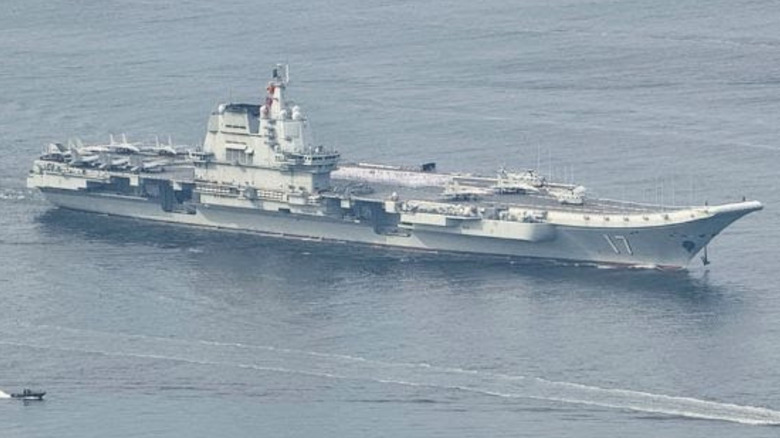China's Newest Aircraft Carrier Shows Off Tech Previously Exclusive To The US
Chinese aircraft carriers may not be able to launch as many fighter jets as U.S. carriers, but that hasn't stopped the country's navy from moving forward with carrier tech. In fact, as seen in footage released in late September 2025, China is now using an electromagnetic catapult system on its newest aircraft carrier, the Fujian. This is the first time that the Electromagnetic Aircraft Launch System (EMALS), has been used outside of the U.S. Navy's USS Gerald R. Ford, the most advanced aircraft carrier in the world. This system is also much different than the ski-jump ramps used on China's other carriers.
Catapults mechanically launch aircraft off the deck, while ski-jumps are merely ramps that curve upwards, giving fighter jets an assist when taking off. While ski-jump ramps are cheaper to build, they're limited to the weight they can handle, which directly impacts an aircraft's payload. The fact that China opted for the heavier and more expensive system perhaps speaks to the continued desire to improve the effectiveness of their naval fleet.
But even as the Fujian launched the J-15T, J-35, and KJ-100 aircraft, it did so using conventional fuel. In contrast, the Gerald R. Ford and Nimitz-class aircraft carriers in the U.S. fleet are nuclear-powered. This difference in design means that American carriers benefit from massive amounts of energy and instead of carrying fossil fuels, they can haul more weapons and ammunition. Nuclear-powered carriers can also stay on the water for over 20 years without refueling.
Tracking China's growing carrier program
China's aircraft carrier fleet is entirely conventionally powered, but that could change in the future. Online reports in late 2024 and early 2025 indicate that a full-scale mock-up at China's Ship Integration Facility showed signs of a nuclear design. If this proves to be true, it would significantly bolster China's fleet of navy warships, and expand its operational reach, allowing them to move further away from their own shores.
Despite their limitations, two of China's current carriers, the Liaoning, and Shandong, have already ventured east of the nation's First Island Chain. The move happened in June 2025, causing concern for the U.S., and Japan, who monitored China's western Pacific activity during that time. That activity included over 1,000 successful takeoffs and landings combined for both Chinese fighter jets and helicopters. This represented the first time two Chinese carriers operated simultaneously on such a scale, up to that point.
China's aircraft carrier program dates back to the 1980s, when Admiral Liu Huaqing first outlined a strategy to build a new Chinese carrier fleet. After years of research and design, China's fleet officially began with the purchase of the Varyag, a half-built Soviet carrier, that the country bought from Ukraine. After nearly 10 years of work, the Varyag became the Liaoning and was launched in 2012. The Shandong followed in 2019, and the Fujian completed the fleet in 2022.

